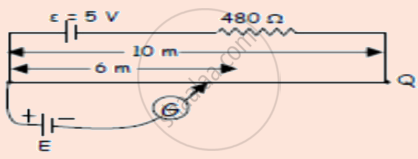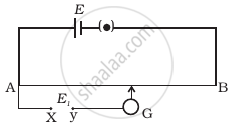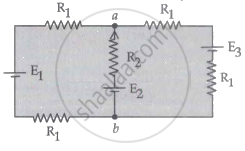Advertisements
Advertisements
प्रश्न
The potentiometer wire AB shown in the figure is 40 cm long. Where should the free end of the galvanometer be connected on AB, so that the galvanometer may show zero deflection?

उत्तर
Let D be the null-point of the potentiometer. Since the bridge is balanced at this point,
\[\frac{R_{AD}}{R_{DB}} = \frac{8}{12}\]
According to the principle of a potentiometer,
\[\frac{R_{AD}}{R_{DB}} = \frac{l_{AD}}{l_{DB}} = \frac{8}{12} = \frac{2}{3} \]
\[ \Rightarrow l_{AD} = \frac{2}{3} l_{DB} \]
\[ l_{AD} + l_{DB} = 40 cm\]
\[ \Rightarrow l_{DB} \frac{2}{3} + l_{DB} = 40 cm\]
\[ \Rightarrow \frac{5}{3} l_{DB} = 40 cm\]
\[ \Rightarrow l_{DB} = 40 \times \frac{3}{5} = 24 cm\]
Hence, the null-point is obtained 24 cm from B.
APPEARS IN
संबंधित प्रश्न
Describe briefly, with the help of a circuit diagram, how a potentiometer is used to determine the internal resistance of a cell.
The net resistance of a voltmeter should be large to ensure that ______________ .
What will be the effect on the position of zero deflection if only the current flowing through the potentiometer wire is increased?
A potentiometer wire has a length of 1.5 m and a resistance of 10 Ω. It is connected in series with the cell of emf 4 Volt and internal resistance 5 Ω. Calculate the potential drop per centimeter of the wire.
Why is a potentiometer preferred over a voltmeter for measuring emf?
The resistance of a potentiometer wire is 8 Ω and its length is 8 m. A resistance box and a 2 V battery are connected in series with iL What should be the resistance in the box if it is desired to have a potential drop of 1 µV/mm?
State any one use of a potentiometer.
A potentiometer is an ideal device for measuring potential difference because ______.
The length of a potentiometer wire is L. A cell of e.m.f E is balanced at length L/3 from the positive end of the wire. If the length of wire increases by L/2, then the same cell will give balance point at length ____________.
If the e.m.f of a cell is not constant in the metre bridge experiment, then the ____________.
To determine the internal resistance of a cell by using potentiometer, the null point is at 1 m when cell is shunted by 3 Ω resistance and at a length 1.5 m when cell is shunted by 6 Ω resistance. The internal resistance of the cell is ______.
A potentiometer is an accurate and versatile device to make electrical measurements of E.M.F. because the method involves ______.
A 10 m long wire of uniform cross-section and 20 Ω resistance is used in a potentiometer. The wire is connected in series with a battery of 5 V along with an external resistance of 480 Ω. If an unknown emf E is balanced at 6.0 m length of the wire, then the value of unknown emf is ______.

Three resistance each of 4Ω are connected to from a triangle. The resistance b / w two terminal is
While doing an experiment with potentiometer (Figure) it was found that the deflection is one sided and (i) the deflection decreased while moving from one end A of the wire to the end B; (ii) the deflection increased. while the jockey was moved towards the end B.
- Which terminal + or – ve of the cell E1, is connected at X in case (i) and how is E1 related to E?
- Which terminal of the cell E1 is connected at X in case (ii)?

For the circuit shown, with R1 = 1.0 Ω, R2 = 2.0 Ω, E1 = 2 V, and E2 = E3 = 4 V, the potential difference between the points 'a' and 'b' is approximately (in V) ______.

In a potentiometer, a cell is balanced against 110 cm when the circuit is open. A cell is balanced at 100 cm when short-circuited through a resistance of 10 Ω. Find the internal resistance of the cell.
